Date: Sunday 2nd September 2018
Location : Swartvlei Beach
By Mark Dixon.
Late Sunday morning the much awaited autopsy of the beached Sperm Whale carcass got underway.
Joining the research team were Dr Stephanie Plon from NMU with Dr Greg Hofmeyr from Bayworld visiting briefly while en route to Cape Town.

The most noticeable external observation was of the advanced onset of bloat that had occurred overnight. The tongue, which wasn’t easily visible on Saturday, had protruded extensively and the right flipper was extended away from the body with a slight rupture on the posterior side where it joined the body.
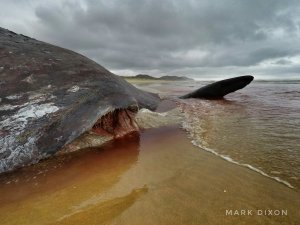
The most noticeable consequence of the bloating was the protrusion of the penis from the genital opening. Later, once the tide had retreated we noticed that the bloat had caused an opening to erupt from the lower back towards the tail with a mass of connective tissue still attached.
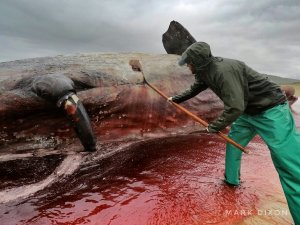
The primary objective was to sample the stomach contents. First two transverse incisions, about 1.2m apart, were made either side of the umbilicus, the area where the umbilical chord was attached as a fetus. With the intention of attaching a rope and using a 4×4 to pull the flap of blubber away, a third longitudinal incision was made, all the while being wary of the possibility of the bloated stomach exploding through the cuts. It did, but fortunately just after Frikkie had stepped away.
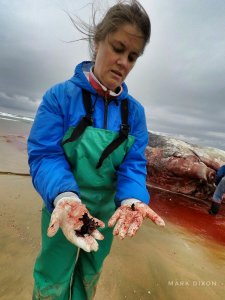
The first contents retrieved were a few small squid beaks and some intestinal parasites.
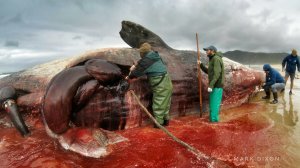
Once the rope was attached to the flap of blubber the tug of war started. It was incredible to see how strong the blubber is. It hardly moved and the 4×4 just spun in the sand. Carefully, Frikkie had to cut along the edges of the flap while the 4×4 pulled the flap, a delicate operation balancing safety and precision slicing.
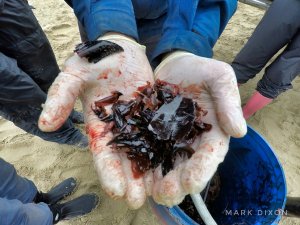
Once a sufficient abdominal opening was made better sampling of the stomach was possible. In all, approximately 7 liters of squid beaks were collected (a volumetric estimate is used as it wasn’t possible to weigh the sample on the beach).
The stomach lining also had a growth in it and tissue samples were taken to determine if it was an ulcer or a tumor.

In addition to the squid beaks a mass of about 5 liters of fishing rope was recovered from the stomach. Though difficult to confirm at the time, it looked like a 4mm down line from a long line setup.
Sperm Whales are remarkable hunters, the largest contemporary predators on the planet. They hunt primarily squid in depths up to 2000m. When checking the size of the squid beaks, the bulk of them were from small individuals with a few from medium sized squid and one beak (that I saw) from a squid that would have been approximately 1.5m depending on species.
Considering the dexterity, rapid and nimble movements of squid, especially the smaller ones it is remarkable to contemplate a 16m Sperm Whale having the agility and stealth to both approach a squid and to catch it. Yet from the beaks in the stomach, it did so successfully.
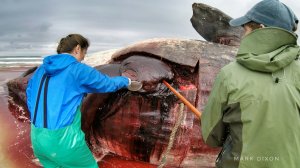
Research of Sperm Whales is by nature difficult and except for behavioural observations often relies on studying dead specimens that have washed up making this a incredibly valuable chance.
With regards to the beaks found in Sperm Whale stomachs it is thought that after digestion of the squid, they do not immediately pass through the digestive tract, but are possibly retained in the stomach as a means of protecting the intestine from the sharp edges.
One theory of their elimination from the stomach is by regurgitation. A second theory is that the Ambergris, which forms in either the intestine or rectum (again no conclusive studies have been possible), is produced to safely eliminate the beaks through the digestive tract.
In terms of the death of this specimen, it is too early to conclude that one particular aspect was the cause of death. While there was rope present in the stomach, it hadn’t prevented the whale from eating and digesting it’s prey. Histology tests will have to be done to determine what the growth in the stomach is and what a possible cause was. Additional tests of tissue samples will also indicate any chemical accumulation.
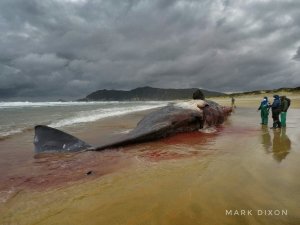
With regards to when the whale died, condition of the skin, decomposition of connective tissue and stomach lining and onset of bloat indicate that it had been dead for between a few days to a week before washing up.
Both Danielle Conry and Frikkie van Der Vyver will continue sampling at low tide on Monday.
A special thanks to both Thembile Mpongoza and Nelson Tyhali, rangers from #SANParks who have assisted tirelessly over the weekend.
#SpermWhale #GardenRoute #Sedgefieldza



Very sad, however having just read the Nat. Geo. issue “Planet or Plastic” also not totally unexpected – we are messing up our only home……………very, very badly!!! All so heartbreaking.